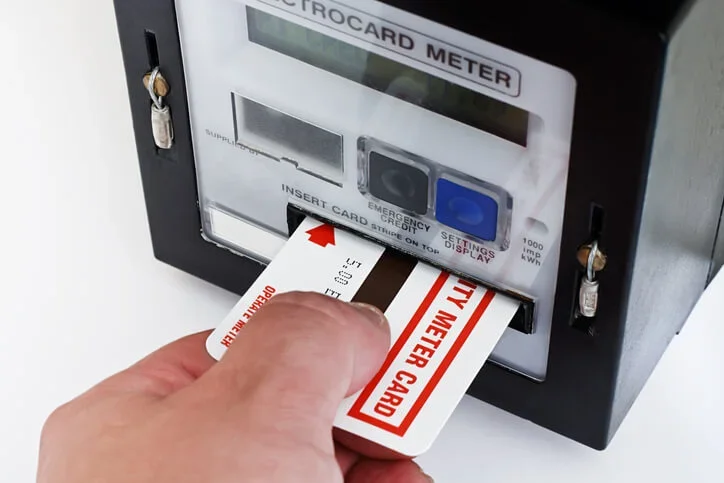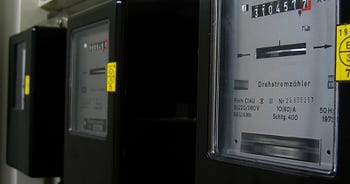What are prepayment meters for business?
Energy costs can quickly add up for UK SMEs, especially when unexpected bills land on your desk. One way to get greater control over your business’s energy spend is by using a prepayment meter. But what exactly are they, and could your business benefit from having one installed?
We’ll break down everything you need to know about prepayment meters, why some SMEs use them, and how they can help your business manage costs more effectively.

Five-point summary
- A prepayment meter lets your business pay for gas and electricity in advance, helping you avoid unexpected bills and stay in control of energy costs.
- You top up using a key or card, monitor your usage via the meter display, and can access emergency credit if needed — offering transparency and flexibility.
- Prepayment meters help manage cash flow, avoid debt, track real-time energy usage, and eliminate estimated bills — ideal for businesses looking for tighter budget control. On the downside, rates on these meters are often more expensive than fixed contract rates.
- You can top up in local shops, Post Offices, online, or by phone (depending on your supplier), with credit transferring via your meter key or card.
- If you're struggling to top up, suppliers may offer support, payment plans or access to grants — and you can switch back to a traditional meter if needed.
What are prepayment meters?
Prepayment meters are a type of energy meter that allows businesses to pay upfront for gas and electricity, helping avoid monthly or quarterly surprise bills.
Instead, you top up your meter and pay-as-you-go, making it easier to manage your finances and energy use. Prepayment meters are also a great option if your business is recovering from debt and needs more control over spending.
How do prepayment meters work?
Prepayment meters function through a simple pay-as-you-go system, giving SMEs full transparency and control over their energy use. But how do they work?
- Understanding the display and readings — Your prepayment meter features a clear display that shows:
- Your remaining credit.
- The daily standing charge (the fixed amount you pay each day for having energy supplied).
- Your current usage rate (how much energy you’re using at the moment).
- Status of any emergency credit being used (the small amount of credit provided by your supplier to prevent you from being cut off when your meter runs low).
- Monitoring your energy usage — Regularly checking your meter’s display helps you stay in the know about your business's consumption patterns. This visibility makes it easier to spot high-usage periods, adjust energy behaviours, and ultimately save money by being more energy conscious.
Can you have a prepayment meter with a smart meter?
Unlike traditional energy meters, smart meters can be remotely switched between credit and prepayment modes by your supplier. Smart meters can also send half-hourly energy consumption data to suppliers, but they aren't the same as half-hourly meters, which are primarily designed for businesses with high energy usage.
If your business has a peak demand of 100 kilovolt-amperes (KVA) or more in any 30-minute period, then you have to install a half-hourly meter. If it has a peak demand above 70 KVA, you can have one fitted if consumption reduction is a priority. Find out more in our guide to energy for large and industrial businesses.
How to use a prepayment meter
Using your prepayment meter is straightforward once you understand the process. Here’s a detailed breakdown:
- Activate your meter
Start by inserting your prepayment key or card into the meter. This will activate your energy supply and transfer any new credit purchased. - Check your balance regularly
Make it a habit to check your meter display regularly. This helps you keep track of how much credit is left so you can plan top-ups and avoid running out of energy to keep your business running properly. - Make sure you know about emergency credit
If your balance runs too low, most meters will offer an emergency credit feature. This provides a small temporary buffer, meaning you can keep your energy supply going while you arrange your next top-up. Be aware that this credit will need to be repaid when you next top up. - Read the display clearly
Your meter’s display not only shows remaining credit but also provides key information about your energy usage, daily charges and whether you’re using emergency credit. Familiarising yourself with these displays means you can manage your energy more effectively.
How do you top up a prepayment meter?
Keeping your meter topped up is easy! Here’s how to stay on top of it:
- Find your meter key or card — Your energy supplier will provide you with a prepayment key or card when your meter is first installed. Make sure to keep this safe, as it’s required for all top-ups.
- Choose your top-up method — You can choose to top up at a local shop, Post Office, online through your supplier’s website or app, or over the phone if your supplier offers this service.
- Purchase your credit — Select an amount of credit that fits your business’s current needs and budget. Make sure you consider how much energy you typically use to avoid having to make more trips than you need to.
- Insert your key or card into the meter — Once you’ve topped up, insert your key or card back into the meter to transfer the new credit over. This means your supply remains active and your business can keep ticking over.
- Confirm successful top-up — Always double-check your meter’s display to confirm that the new credit has been added. If there are any issues, contact your supplier straight away.
Where can you top up a prepayment meter?
There are a few different options for topping up your prepayment meter, depending on your supplier and what suits you best:
- Local corner shops — Many local corner shops and newsagents offer PayPoint or Payzone services, allowing you to top up your meter quickly while out and about.
- The Post Office — A reliable and widely accessible option for businesses that are near a Post Office branch.
- Online (if offered by your supplier) — Many suppliers now offer online top-ups via their website or app. This method is fast, convenient and available 24/7 — perfect for busy business owners!
- Over the phone (if offered by your supplier) — Some suppliers allow you to top up by calling their automated phone line or customer service team. This is a great option if you need a quick top-up but can’t get to the shop or online.
What are the benefits of a prepayment meter?
Prepayment meters offer a whole range of benefits that can be particularly useful for SMEs wanting to manage energy costs more effectively.
Greater control over your energy spend
With a prepayment meter, you pay for energy upfront, meaning you’re only ever using energy you’ve already paid for.
This gives you total visibility of your costs and helps avoid unexpected bills or large payments at the end of the month. For busy SMEs, this level of control can make managing energy spend a whole lot simpler, especially when you’re balancing energy costs alongside other outgoings.
Improved cash flow management
Cash flow is a big priority for many SMEs, and prepayment meters can help with that too.
Because you can choose how much to top up and when, you can match your energy spending to your business’s cash flow. If you know it’s a quieter trading period, you can top up with a smaller amount, helping to free up cash for other expenses.
This flexibility makes it easier to keep on top of your finances, without the worry of falling behind on energy payments.
Reduced risk of accumulating debt
If your business has struggled with energy debts in the past or you simply want to avoid getting into that situation, a prepayment meter could be a good fit.
Because you pay before using any energy, you can’t unknowingly rack up debt on your account. This makes prepayment meters a convenient option for businesses wanting to keep total control over outgoings, or those looking to rebuild from previous debt.
Greater visibility of usage
Prepayment meters give you a clear view of how much energy your business is using, in real time. The meter display shows your remaining credit and current usage, so you can instantly see if certain equipment or behaviours are driving up your costs.
With this visibility, it’s much easier to spot ways to save energy and make more informed choices about how your business uses it.
No estimated bills
One of the big frustrations with traditional energy billing is receiving estimated bills, which can lead to nasty surprises.
With a prepayment meter, you avoid that altogether. You’ll only ever pay for the energy you actually use — no more, no less. This gives you great peace of mind and means you’re not being charged based on estimates that may not reflect your real usage.
What are the disadvantages of a prepayment meter?
Higher costs
Prepayment tariffs can still be more expensive than standard credit tariffs, especially if you're on a default or out-of-contract rate.
Running out of credit
If you forget to top up or can’t access a top-up point, your business could temporarily lose power, disrupting operations.
Less convenient for busy businesses
Monitoring credit and manually topping up takes time and may not suit fast-paced or remote-working businesses.
Limited tariff options
You may have fewer choices when it comes to switching to a cheaper deal, as not all suppliers offer competitive prepay tariffs.
Emergency credit is only temporary
While helpful in a pinch, emergency credit must be repaid next time you top up, which can eat into your available funds unexpectedly.
What happens if you’re in credit or debit with your old supplier?
When switching to a prepayment meter or moving to a new supplier, it’s important to understand how existing credit or debit is handled.
- Claiming back your credit — If you have remaining credit with your old supplier after switching, they’re required to refund it to you. This process is usually automatic, but follow up with them if you don’t receive your refund within the time they state (this can sometimes be up to 14 working days).
- Switching suppliers if you’re in debt — In most cases, you’ll need to clear any outstanding debts before switching to a new supplier. However, if you owe less than a certain threshold (usually around £500), some suppliers may agree to take on the debt and allow you to switch. Always check with both your current and new suppliers to understand all your options.
What to do if you can’t afford to keep the meter topped up
If you're struggling to pay your energy bills and keep the meter topped up, don’t panic, there’re some options available for help:
- Emergency credit and support — Most prepayment meters include some form of emergency credit to tide you over if you run out of credit outside business hours or before you can arrange a top-up. But, be aware, this credit must be repaid during your next top-up.
- Negotiating with your supplier — If you’re consistently struggling to keep the meter topped up, contact your supplier straight away. They may be able to offer a temporary payment plan, review your tariff, or provide advice on how your business can save energy.
- Financial assistance and grants — Look into whether your business qualifies for any energy grants, government support schemes, or charitable funds that can help cover energy costs or support the shift to greener energy. Your supplier should also be able to point you in the right direction of available resources.
Can you have a prepayment meter removed?
Yes, in many cases, you can request to have your prepayment meter removed and replaced with a traditional credit meter or a smart meter set to credit mode.
Your supplier will typically assess your payment history to make sure you can manage regular bills. They may also conduct a credit check as part of the process.
Does a prepayment meter affect your credit rating?
No, a prepayment meter does not directly affect your business credit rating.
Credit ratings are typically impacted by how you manage credit agreements — like loans, credit cards, or business energy accounts billed in arrears. Since prepayment meters require you to pay upfront for energy, there's no credit involved, so your usage isn’t reported to credit reference agencies and won’t influence your score.
But if you do have a low business credit rating, suppliers may insist on fitting a prepayment meter. You can find out more in our guide to business energy and credit scores.
Can your supplier force you onto a prepayment meter?
Suppliers can sometimes install a prepayment meter if your business consistently misses payments, but this is often a last resort.
They must follow strict rules, including giving you proper notice and considering any vulnerabilities you disclose. If you’re struggling to pay, always contact your supplier early to talk through your options.
Are prepayment meters more expensive?
Historically, prepayment meters came with slightly higher standing charges and unit rates, but the gap has narrowed in recent years thanks to the energy price cap — it’s still worth checking your supplier’s rates to make sure you’re getting a fair deal.
Sort your business energy with Bionic
Prepayment meters can give SMEs greater control over their energy costs, help manage cash flow and reduce the risk of debt building up.
If you need help getting your energy in shape, get in touch with our experts to find the best business energy, gas, or electricity for you. Or, head over to our energy guides to find out everything you need to know.








